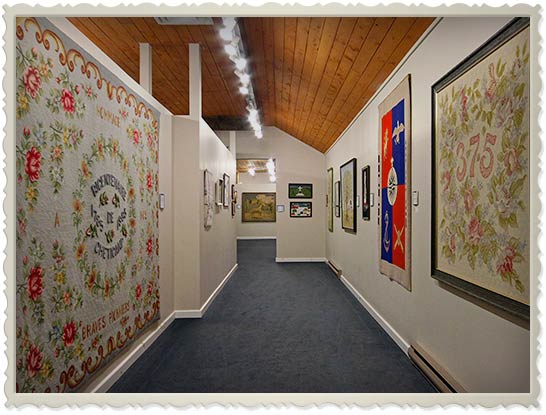|
Les Trois Pignons at 15584 Cabot Trail Road, Cheticamp, Cape Breton (12 October 2012) Several years ago, at another Celtic Colours Festival, I took a rug hooking class and fell in love with the craft. After trying my hand at the hoop several more times I accepted that I have no skill at it, but I've never lost my appreciation for the beautiful creations others have made. Therefore, a jaunt up the Ceilidh Trail to Cheticamp, basically the headquarters of rug hooking, was a little dream come true. We visited the Musee' le Trois Pignons, where I was surrounded by hooked art and in heaven. Although the museum features other aspects of daily living in the 1800s, such as tools and household wares, the main attraction is the rugs.
As I rounded the corner I noticed a less complicated, yet equally lovely blocked piece, alternating stripes and flowers. Although an example of early patterns, the design is surprisingly modern.
Most of the rest of the museum is devoted to the Elizabeth Lefort Gallery, famous for her portraits. She hooked Jacqueline and John F. Kennedy, the first U.S. astronaut team, the Prince of Wales and Queen Elizabeth II, among many other famous figures. Numerous works are religious in nature, including Jesus as a boy, Jesus with angels and a crucifixion scene, which in 1964 took 11 months to make. I preferred a scene of daily life, a pastoral portrait of a shepherd with his sheep, cottage in the background, heading toward a duck pond, worked in beautiful sepia-toned colors. Born in 1914, Lefort learned to hook at an early age. A piece she worked for her sister caught the eye of Kenneth Hansford, who offered to buy all her future work. From then on she spent summers working for him in his shop in Margaree Forks, demonstrating her craft for tourists and creating hundreds of tapestries. Her portrait of U.S. President Dwight Eisenhower was presented to him at the White House in 1957, and her art is hung in both Buckingham Palace and Vatican City. Rug hooking in North America was very popular by the 1800s, with most of the designs being simple flowers or geometrical shapes, the patterns created by the workers themselves. Wool was tinted using tree bark, mosses and onion peels for dye. Unfortunately, due to the fragile nature of the fibers and the hard use the rugs took, few early examples of the art still exist. By the turn of the 19th century, pre-printed designs became widely available and more complicated rugs began to be hooked, land- and seascapes being among the most popular. Rugs were originally sold by door-to-door by salesmen who turned them around for high profit. I regretted leaving the museum, but a quick look in the gift shop cheered me. They happen to sell, among many others, an excellent book on the subject, The Story of the Hooked Rugs of Cheticamp by Anselme Chiasson and Annie Rose Deveau. I don't recommend leaving without buying a copy. Our trip to Cheticamp was completed at the Hometown Kitchen, a tasty restaurant where there was hanging, of course, a "Home Sweet Home" hooked rug.  |

Rambles.NET music review by Katie Knapp 1 December 2012 




|

 The first to catch my eye was an intricate piece, a ship at sail in tropical waters, surrounded by flowers and palm trees. The piece is unnamed and not attributed to an artist.
The first to catch my eye was an intricate piece, a ship at sail in tropical waters, surrounded by flowers and palm trees. The piece is unnamed and not attributed to an artist.
 On the opposing wall is an enormous rug celebrating the "Bicentenaire De Cheticamp," 1785-1985, in raised letters surrounded by flowers with the words "Hommage Braves Pionniers" worked into the pattern. The piece took more than three months to make, including 90 colors, 18 pounds of wool and 130,6368 stitches, created by the great Cheticamp artists Annie Rose Deveau, Marie Helene Maillet, Lorraine Poirier and Marie Edna Roach. Gerard Deveau, famous in the area for his rug designs, created the pattern.
On the opposing wall is an enormous rug celebrating the "Bicentenaire De Cheticamp," 1785-1985, in raised letters surrounded by flowers with the words "Hommage Braves Pionniers" worked into the pattern. The piece took more than three months to make, including 90 colors, 18 pounds of wool and 130,6368 stitches, created by the great Cheticamp artists Annie Rose Deveau, Marie Helene Maillet, Lorraine Poirier and Marie Edna Roach. Gerard Deveau, famous in the area for his rug designs, created the pattern.